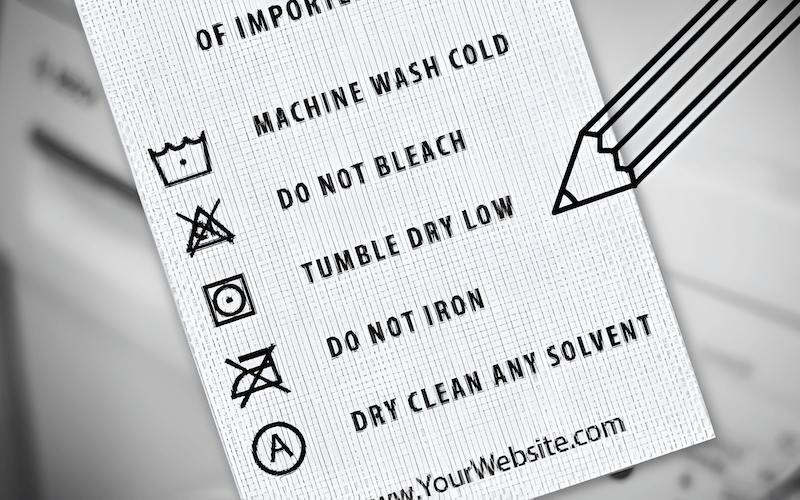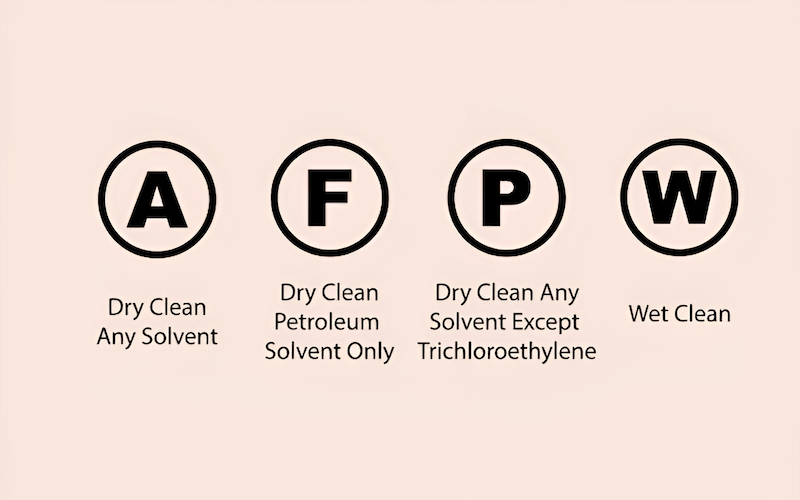UK Dry Cleaning Symbols Explained: A Complete Guide 2025
Decoding those cryptic symbols on your clothing tags can be a real challenge. Many people in the UK are unsure about the meaning of dry cleaning symbols, leading to worries of shrunken sweaters or faded dresses. Proper garment care is crucial for preserving your favorite pieces and avoiding costly mistakes.
This guide will empower you to understand every UK dry cleaning symbol. You’ll learn about the different cleaning methods and solvents, enabling you to make informed choices. From everyday wear to delicate items, we’ll help you keep your wardrobe looking its best, and when to consult with professionals. This complete guide will make sure readers can confidently identify and decode all the dry cleaning symbols in the UK.
1. Understanding dry cleaning symbols in the UK
1.1 Why are care labels important?
Care labels are more than just small tags; they’re your guide to protecting and extending the life of your clothes. These labels provide crucial washing instructions, helping you prevent damage like shrinking, fading, or fabric distortion. Following these instructions ensures your garments stay looking their best for longer.
In the UK, care labels are also a legal requirement, ensuring consumers receive accurate information about textile care. These regulations help promote responsible clothing ownership and minimize the risk of accidental damage. By understanding care labels, you’re taking an active role in garment care and contributing to a more sustainable approach to fashion.

1.2 The basic dry cleaning symbol: The circle
The foundation of all dry cleaning symbols is the circle. This simple shape signifies that professional cleaning is either recommended or required for the garment. Always look for the circle on your clothing’s care label to determine if dry cleaning is necessary. Remember, it is always better to dry clean.
Variations within the circle, such as letters or a cross, provide more specific instructions. These variations indicate the types of solvents that can be used, or whether dry cleaning should be avoided altogether. Understanding these nuances is key to proper textile care.
1.3 Deciphering the letters: P, F, and A
Different letters inside the circle specify which solvents are safe for your garment. Here is quick explanation:
- P: Garments marked with a “P” can be dry cleaned with any solvent except trichloroethylene. Trichloroethylene has been restricted due to environmental and health concerns.
- F: An “F” indicates that only petroleum solvents, such as white spirit, should be used. These are hydrocarbon-based solvents that are gentler on some fabrics.
- A: While less common now, an “A” means any solvent can be used. This has decreased in popularity due to growing environmental awareness regarding certain cleaning chemicals.

1.4 The “Do not dry clean” symbol
A circle with a cross through it is a clear and crucial instruction: “Do Not Dry Clean.” This symbol means the garment should not be subjected to any dry cleaning process, as it could cause irreversible damage.
If a garment is marked “Do Not Dry Clean,” check the rest of the care label for alternative washing instructions. These might include hand washing or using a gentle machine wash cycle. Always prioritize the care label’s guidance to maintain the item’s quality.
1.5 Other variations and additional markings
Sometimes, you’ll find lines underneath the dry cleaning circle. These lines provide even more detail for the professional cleaner. One line indicates a short cycle.
Additional markings might also relate to specific dry cleaning settings. These instructions ensure the most appropriate cleaning process is applied to protect your garment.
2. Beyond the circle: Connecting symbols to the dry cleaning process
2.1 What happens during dry cleaning?
Dry cleaning is a specialized process that cleans clothes using chemical solvents instead of water. This method is particularly effective for removing stains, dirt, and odors from delicate fabrics that might be damaged by traditional washing. The solvents dissolve substances without penetrating the fibers.
The solvent cleaning process is gentle on materials like silk, wool, and velvet, preserving their shape and texture. While it’s called “dry” cleaning, the garments are immersed in a liquid solvent, but this liquid doesn’t contain water. Professional cleaning ensures your clothes receive the best possible care.
2.2 Types of dry cleaning solvents
Several types of solvents are used in dry cleaning, each with its own properties and considerations. Perchloroethylene (Perc) has been a common choice, but concerns about its environmental impact have led to a shift towards alternatives. Hydrocarbon solvents, such as those derived from petroleum, are also widely used.
“Greener” options are becoming increasingly available. Liquid CO2, which uses captured carbon dioxide, is a more sustainable choice. Wet cleaning, which uses water and specialized detergents, can also be an environmentally friendly alternative.
3. Practical advice and tips
3.1 When in doubt, consult a professional
If you’re ever unsure about a care label symbol, or if you have a particularly delicate or valuable garment, always consult a professional dry cleaner. They have the expertise and experience to interpret the symbols accurately and choose the best cleaning method.
Finding a reputable dry cleaner in the UK is easy. Start by asking for recommendations from friends or family. Online reviews and trade association websites can also provide valuable insights. Don’t hesitate to seek expert advice when it comes to caring for your clothes.

3.2 Caring for your clothes between dry cleaning visits
To keep your clothes looking their best and extend the time between dry cleaning visits, follow some simple garment care practices. Proper storage is key: hang delicate items on padded hangers and fold knitwear to prevent stretching. Avoid storing clothes in plastic bags, which can trap moisture and lead to mildew.
Airing out clothes after wearing them can help remove odors and refresh the fabric. Spot cleaning can be attempted for minor stains, but proceed with extreme caution and only on suitable fabrics. Always test any spot-cleaning solution on an inconspicuous area first.
4. FAQs about UK dry cleaning symbols
4.1 What if my garment label only has washing symbols, but no dry cleaning symbol?
The absence of a dry cleaning symbol doesn’t necessarily mean the garment can’t be dry cleaned. It simply means the manufacturer hasn’t provided specific dry cleaning instructions. It’s always best to consult a professional dry cleaner in such cases. They can assess the fabric and determine the safest and most effective cleaning method.
4.2 Can I dry clean a garment at home?
Home dry cleaning kits are available, but they have significant limitations. These kits typically use a combination of stain removers and a dryer bag with a moist cloth. While they might refresh clothes, they don’t provide the same deep clean as professional dry cleaning. For valuable or delicate garments, professional dry cleaning is strongly recommended to avoid damage.
4.3 What does the “W” in a circle mean?
A circle with a “W” inside indicates professional wet cleaning. This is a gentler alternative to traditional dry cleaning that uses water and specialized detergents. Wet cleaning is often suitable for garments that can’t withstand the chemicals used in dry cleaning.
4.4 Are dry cleaning symbols the same worldwide?
While the GINETEX system, which includes dry cleaning symbols, is widely used internationally, there can be some regional variations. The UK follows the GINETEX standards, ensuring consistency across most care labels. When in doubt, always check the specific symbols on your garment.
4.5 How often should I dry clean my clothes?
The frequency of dry cleaning depends on several factors: the garment type, fabric, how often it’s worn, and how soiled it becomes. There’s no one-size-fits-all answer. Items like coats and suits may only need occasional dry cleaning, while frequently worn items might require more frequent attention.
5. Packlove – Providing service for Care Labels
Packlove is your one-stop shop for custom packaging and labeling solutions. We understand that care labels are essential for communicating proper garment care to your customers. We offer range of products, include Value Booster Kit, Woven Labels, Heat Transfer Labels, Rubber Labels, Zipper Bags, Poly Mailers.
Our services extend beyond just dry cleaning labels. We provide a wide range of custom labeling options, including woven labels, heat transfer labels, and rubber labels, to help you create a complete and professional brand identity. With years of experience and commitment to best quality.
Contact us today to discuss your labeling needs! Visit our website at https://mypacklove.com/, email us at [email protected], or give us a call at +84 363615867. We’re here to help you create labels that are both informative and visually appealing.
Read more:
Understanding UK dry cleaning symbols is essential for proper garment care. The circle is the key symbol, with letters (P, F, A) indicating the allowed solvents, and a cross signifying “do not dry clean.” Remember to always check the entire care label.
By deciphering these symbols, you can protect your clothes, extend their lifespan, and avoid costly mistakes. When in doubt, don’t hesitate to consult a professional dry cleaner. Taking the time to understand care labels is an investment in your wardrobe and ensures your garments stay looking their best for years to come.






















